Welcome to U.S. DOE Occupational Medicine!
Occupational medicine, broadly defined, concerns "all aspects of the relationship between work and
health and it is to a large degree concerned with the impact of work on the development of medical
disorders" (NRC 1988a). U.S. DOE Occupational Medicine therefore serves a wide range of programs as
reflected in this inaugural issue. The content of the webpage and newsletter is therefore a
reflection of the needs and concerns of the DOE community and subject to change as circumstances dictate.
This webpage and newsletter is an interactive means of communication between DOE's Office of Health
and Safety (HS-10) and occupational health providers and managers across the DOE Complex. In an era of
changing social, economic, and scientific influences, ensuring workplace health and safety requires a
multidisciplinary program with subject matter experts from a wide range of medical and scientific
disciplines. It is also critical in a network of occupational health providers to continually strive
to improve upon our service to the workers who play a central role in DOE's workplace safety system.
Leading by Example:
HSS Seeking VPP Star Status |
 |
Office of Worker Safety and Health Assistance Director Brad Davy recently presented his vision to
staff at headquarters for achieving Star Status under OSHA's VPP. Attainment of VPP Star Status will
confirm that HSS exceeds OSHA requirements for occupational health and safety and will enable HSS
to truly "lead by example" in encouraging additional VPP applications from sites across the DOE
Complex. An HSS VPP Committee made up of HSS staff and managers is creating a website to foster
2-way communications over the 18-24 months expected time to achieve star status with the expectation
that positive impact of VPP Star Status will continue far into the future! Contact: Ms. Colette
Broussard (Colette.broussard@hq.doe.gov, 301-903-5452).
Farewell and Thank You, Dr. Bill Brady of LANL
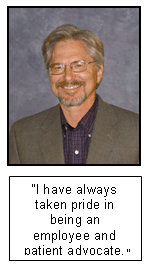 Dr. Bill Brady will be retiring October 24, 2008 from his position as the Site Occupational
Medical Director (SOMD) at the Los Alamos National Laboratory (LANL) where he has served with
distinction since 2003. He has provided valuable leadership of 65 medical staff in the delivery
of occupational health services to 12,000 DOE workers.
Dr. Bill Brady will be retiring October 24, 2008 from his position as the Site Occupational
Medical Director (SOMD) at the Los Alamos National Laboratory (LANL) where he has served with
distinction since 2003. He has provided valuable leadership of 65 medical staff in the delivery
of occupational health services to 12,000 DOE workers.
He has previously served as the SOMD at the Hanford-Richland site from 1997 to 2003.
He was elected to the position of Chair of the Energy Facilities Contractors Group's (EFCOG)
ES&H Working Group Occupational Medicine Subgroup's Steering Committee in April 2003.
In this role, he has organized the DOE medical directors through regular educational
conferences, and conference calls to gain consensus.
Dr. Brady had a distinguished career graduating from Texas A&M College of Medicine, and he obtained
masters degrees in Science in Health Administration, Business Administration, and Public Health.
Dr. Brady has worked closely with the local hospitals at both DOE sites, serving as Chair of the
Department of Occupational Medicine at the Kadlac Medical Center in Richlands; and as Chair of the
Board of Directors of the Los Alamos Medical Center for 4 ½ years. He is board certified in
occupational medicine, and is a certified physician executive. His leadership in the field of
Occupational & Environmental Medicine is highlighted by his service on the advisory boards for
the University of Utah, the NIOSH Educational Resource Center, and the University of Colorado
Health Sciences Center NIOSH Educational Resource Center. Dr. Brady says that trying to list
his accomplishments as Chair of the EFCOG Occupational Medicine Subgroup's Steering Committee
would really be placing the spotlight on the wrong person. "In reality, it was the combined
effort of occupational health providers from across the DOE Complex that has enhanced the health
and safety of the workplace for the employees." On October 27, 2008, Dr. Brady will begin his
new position as Medical Director of Occupational Medicine and Patient Safety at Presbyterian
Health System in Albuquerque, New Mexico. Although it will be a tall order, we trust that
LANL and the EFCOG Steering Committee will identify a similarly dynamic successor to fill his shoes!
DOE's 10 CFR 851 Worker Safety and Health Programs: Walking the Walk
The implementation of 10 CFR 851 Worker Safety and Health Programs is an exciting step in the
evolution of health and safety programs within the DOE Complex. Ensuring that workers benefit from
an assessment of the hazards they face and the establishment of appropriate safeguards requires an
ongoing awareness of work being performed at each site, as well as the latest developments in medical
surveillance. Challenges range from establishing health and safety programs associated with
decommissioning of former nuclear-work facilities to the design of new facilities associated
with nanoscale research. 10 CFR 851 supersedes DOE Order 440.1a. Key distinguishing features
between 851 and 440.1a include requirements for more involvement of the occupational medicine
programs in site safety and health programs, and imposition of financial penalties for non-compliance.
Successful implementation will require continuous efforts on the part of all stakeholders and the
support of HS-10. DOE HQ staff work closely with DOE Field Elements to ensure appropriate
implementation of 10 CFR 851.
Contact: Dr. Bill McArthur (bill.mcarthur@hq.doe.gov
or (301) 903-9674).
Meeting the Need: FWP Assisting Cold Warriors
The Former Worker Medical Screening Program (FWP) began in 1996 and provides outreach and
medical screening activities to any former DOE worker who requests the service. This program
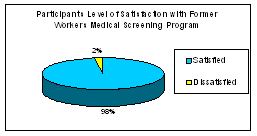 directly benefits former DOE workers by promoting early identification of health problems and
improving the understanding of health risks that former workers may face because of possible
workplace exposures during their prior employment with DOE. The collected program information
is also used to implement controls for current operations in order to prevent or reduce negative
health effects for current and future employees. The program has contacted nearly 500,000 former
workers, already. Of that total, 64,606 workers requested screening and 52,486 have been screened.
All participants are offered an opportunity to express their level of satisfaction with the
screening program. The latest analysis of the satisfaction surveys shows a positive rating of 97.8%.
directly benefits former DOE workers by promoting early identification of health problems and
improving the understanding of health risks that former workers may face because of possible
workplace exposures during their prior employment with DOE. The collected program information
is also used to implement controls for current operations in order to prevent or reduce negative
health effects for current and future employees. The program has contacted nearly 500,000 former
workers, already. Of that total, 64,606 workers requested screening and 52,486 have been screened.
All participants are offered an opportunity to express their level of satisfaction with the
screening program. The latest analysis of the satisfaction surveys shows a positive rating of 97.8%.
A special effort is underway to create a seamless continuum between the screenings
offered current workers and their subsequent enrollment in the
appropriate Former Workers Program (FWP). DOE site occupational
medicine directors (SOMD) are being provided updates on the numbers
and types of conditions being found among the former workers.
SOMDs are being provided material on the FWP to distribute to
current workers when they have exit physical examinations. The
FWP also plays a vital role in assisting the Energy Employees
Occupational Illness Compensation Program (EEOICP), administered
by the Department of Labor, by providing DOE workers with medical
evaluations conducted by expert occupational medicine physicians
and laboratories that provide both claimants and the claims evaluators
with defensible information for decision-making about the appropriateness
of compensation. Contact: Ms. Mary Fields (mary.fields@hq.doe.gov,
301-903-1613).
EEIOCP Offers Financial Compensation to DOE Workers
The Energy Employees Occupational Illness Compensation Program (EEOICP) is a
joint effort between DOE, the Department of Labor (DOL), and the U.S. Department of Health
and Human Services' National Institute of Occupational Safety and Health (NIOSH) to provide
workers with compensation if they are demonstrated to have an illness related to their DOE work.
DOE provided more than 22,000 records packages to both DOL and NIOSH in 2007, alone, for their
evaluations of cases and determinations of compensation for workers and select vendors. |
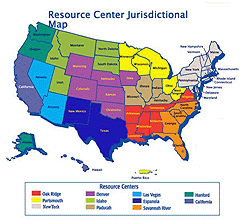 |
To date, DOL has paid out in excess of $4 billion to more than 68,000 individual DOE workers
or survivors. In support of the DOE program, NIOSH has completed more than 18,000 dose
reconstructions on behalf of cancer claimants. EEOICP has also established Special Exposure
Cohorts (SEC) for certain classes of employees to facilitate their claims. To learn more
about these special groups of employees and whether you fit into one of the categories of
the SECs, go to: http://www.dol.gov/esa/owcp/energy/regs/compliance/law/SEC-Employees.htm.
DOE is particularly committed to increasing access to and enrollment in the EEOICP.
Staff from DOE headquarters regularly travels to meetings between EEOICP managers and workers
in an effort to facilitate this complex process. As in any workers' compensation program
addressing conditions which may appear long after the exposure, it is critical that workers be
educated about the potential association and the opportunities available for compensation and
continuing medical care.
Eleven DOE Resource Centers across the Nation that are currently part of EEOICP serving as
outreach to assist workers and their families to apply for benefits. To learn more about the
resource centers, go to: http://www.dol.gov/esa/owcp/energy/regs/compliance/roles.htm
Contact: Ms. Regina Cano (regina.cano@hq.doe.gov, 202-586-4455).
Injury and Illness Prevention: The Key to Health and Safety
The Office of Injury and Illness Prevention (HS-13) within HS-10 promotes the most current concept
in occupational health services - "an ounce of prevention is worth a pound of cure." Although there
persists a historical schism between the practices of preventive and clinical medicine both in the
U.S. and abroad, DOE supports the practice of preventive medicine in several ways, including making
efforts to recruit best and brightest to our occupational medicine teams across the Complex and
supporting their efforts to identify preventable conditions and to design appropriate preventive
interventions. Over time, we will be profiling initiatives in the complex which have demonstrated
the value of preventive medicine.
Examples of preventive medicine programs range from providing facilities and training for
physical fitness on site to conducting medical screenings for risk factors for the diseases
that threaten our workers. For example, a DOE-funded cardiovascular disease screening program
at the Pantex facility in Texas demonstrated the high value in lives, health, and financial savings.
The 10-year intervention saved at least 31 lives and resulted in reduced cardiovascular risk to
hundreds of workers, resulting in estimated savings of $134 M. Nevertheless, it remains a challenge
to secure support and funding for many preventive services.
Dr. Bonnie Richter and the staff of HS-13 endeavor to obtain and analyze the most current data
available from the DOE workforce in order to identify sentinel health events, clusters, and trends
within the DOE workforce to find possible means of improving health and safety. In addition, HS-13
funds and coordinates the activities of NIOSH researchers who are working to characterize the past
exposures of workers from many different DOE facilities. Contact:
Dr. Bonnie Richter (bonnie.richter@hq.doe.gov, 301-903-4501).
"With Health and Safety For All:" Assisting Organized Labor
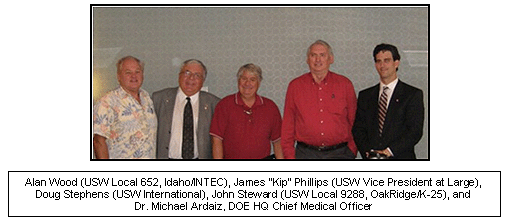
The Office of Health and Safety (HS-10) continues to work very closely with organized labor on
many fronts in service to both current and former workers. HS-10 personnel have met regularly with
members and leaders of AFL-CIO constituent organizations in both headquarters and field sites to ensure
access to information and services. For example, the United Steel Workers (USW) recently hosted DOE's
CMO, Michael Ardaiz, MD, MPH, at their 2008 United Steelworkers' Health, Safety, and Environment
Conference in Pittsburgh, PA where he outlined the principles of fitting the job to the worker with
respect to the Americans with Disabilities Act and reasonable accommodations. Dr. Ardaiz was
thereafter invited to lead a round-table discussion of the Atomic Energy Workers Council (AEWC)
in Washington, DC where labor leaders would be addressing DOE-related objectives. The Office of
Health and Safety recognizes that maintaining a strong working relationship with organized labor
is critical to supporting worker health and safety across the Complex!
Contact: Dr. Michael Ardaiz (michael.ardaiz@hq.doe.gov, 301-903-5926).
International Health Studies
The Office of International Health Studies within HS-10 supports the largest international health
programs in the field of radiobiology. Populations with a history of exposure to radiation, including
individuals from the Republic of the Marshall Islands, Japan, Russia, and Spain, currently receive
support for medical monitoring, treatment, and/or scientific investigations into the effects of
previous radiation exposures. These programs in some cases require the delivery of specialized medical
and environmental services in remote locations, while in other cases patients may be transported to
tertiary care facilities for consultations and specialized treatments. DOE experts collaborate on a
daily basis with international partners in the care of patients and the management of scientific investigations.
For example, a team led by Dr. Patricia Worthington recently traveled to Southern Spain to assist in
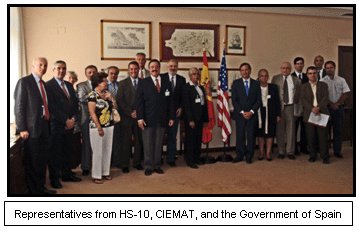 the review of medical and environmental efforts in the community of Palomarès, Spain. This important
collaboration has highlighted the DOE's expertise in the area of health and safety both inside and outside
the DOE Complex. Most importantly, the combined efforts of the Spanish CIEMAT, the DOE's Office of Health
and Safety, and DOE expert Dr. Terry Hamilton from Lawrence Livermore National Laboratory have demonstrated
the commitment to go the extra mile in ensuring public as well as employee safety!
Contact: Dr. Gerry Petersen (gerald.petersen@hq.doe.gov, 301-903-2340).
the review of medical and environmental efforts in the community of Palomarès, Spain. This important
collaboration has highlighted the DOE's expertise in the area of health and safety both inside and outside
the DOE Complex. Most importantly, the combined efforts of the Spanish CIEMAT, the DOE's Office of Health
and Safety, and DOE expert Dr. Terry Hamilton from Lawrence Livermore National Laboratory have demonstrated
the commitment to go the extra mile in ensuring public as well as employee safety!
Contact: Dr. Gerry Petersen (gerald.petersen@hq.doe.gov, 301-903-2340).
Supporting ISM Through Occupational Health Services
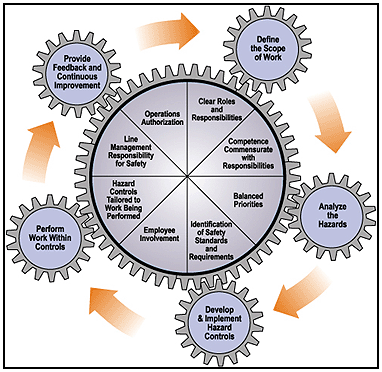 Since its inception in 2006, the Office of Health and Safety has made significant contribution
towards invigoration of Integrated Safety Management (ISM) throughout the Department. Relative to
occupational health, HS-10 is supporting occupational health providers in their efforts to enhance
safety culture by making use of Human Performance Indicators in a process similar to "Human Subsystems"
adapted by the National Institute for Occupational Safety & Health (NIOSH). Considering the fact
that both physical and mental aspects of worker health contribute directly to workplace injuries and
illnesses, HS-10 has increased its emphasis on improving the Department's occupational health services.
For example, HS-10 supports the implementation of 10 CFR 851 Worker Safety & Health Program which
broadens the health and safety services available to more than 100,000 DOE workers. Find the
presentations and documents from the 2008 DOE ISM Conference in Idaho Falls, ID at:
https://secure.inl.gov/ismws08/presentations.aspx.
HS-10 remains available for consultations in support of ISM. Contact: Dr. Ali Ghovanlou
(ali.ghovanlou@hq.doe.gov, 301-903-8805).
Since its inception in 2006, the Office of Health and Safety has made significant contribution
towards invigoration of Integrated Safety Management (ISM) throughout the Department. Relative to
occupational health, HS-10 is supporting occupational health providers in their efforts to enhance
safety culture by making use of Human Performance Indicators in a process similar to "Human Subsystems"
adapted by the National Institute for Occupational Safety & Health (NIOSH). Considering the fact
that both physical and mental aspects of worker health contribute directly to workplace injuries and
illnesses, HS-10 has increased its emphasis on improving the Department's occupational health services.
For example, HS-10 supports the implementation of 10 CFR 851 Worker Safety & Health Program which
broadens the health and safety services available to more than 100,000 DOE workers. Find the
presentations and documents from the 2008 DOE ISM Conference in Idaho Falls, ID at:
https://secure.inl.gov/ismws08/presentations.aspx.
HS-10 remains available for consultations in support of ISM. Contact: Dr. Ali Ghovanlou
(ali.ghovanlou@hq.doe.gov, 301-903-8805).
Promoting Occupational Health Services in the Field: Showcasing Success
Promoting quality occupational health services has never been more important than today!
Although Occupational & Environmental Medicine has been a boarded specialty of the American Board
of Preventive Medicine (ABPM) since 1955 and the field has gained significant momentum with the passage
of the 1970 Occupational Safety and Health Act, professionals in the field have been hard-pressed to
provide evidence to employers of a clear return-on-investment. It is therefore important that
occupational health professionals understand and employ the means to communicate to employers both
direct and indirect costs associated with injuries, illnesses, and disabilities in the workplace.
Three organizations have taken the lead in this respect: the American College of Occupational &
Environmental Medicine (ACOEM); the American Association of Occupational Health Nurses (AAOHN),
and the Centers for Disease Control and Prevention (CDC). Each provides resources that can be
used to educate employers and to gain support and funding for traditional services, as well as
health promotional activities and interventions. Demonstrating improved outcomes and cost savings
can be performed through interviews and surveys, as well as through larger scale epidemiologic studies.
Any effort is better than none! Contact: Ms. Claudia Beach
(claudia.beach@hq.doe.gov or 301.903.9826).
DOE Healthcare Goes Global!
|
 |
Although the DOE has collaborated with international partners since President Harry S. Truman
signed the McMahon/Atomic Energy Act on August 1, 1946, transferring the control of atomic energy
from the military to civilian control on January 1, 1947, the health of DOE workers abroad has become
an increasing concern. In addition to declining immunization rates among the U.S. general population,
infectious diseases including but not limited to polio and avian influenza threaten to spread their impact.
Travel abroad is receiving increased interest and attention from HS-10 as well as those program
offices tasked with managing risks to DOE workers. For example, DOE Order 551.1c (Approved 6-24-08),
includes provisions to ensure that DOE workers traveling to both sensitive and non-sensitive
countries are provided relevant information regarding their health and safety, as well as appropriate
immunizations. The Office of Health and Safety and Security recognizes that injury and illness
abroad is a threat to the mission of DOE. The DOE depends upon the specialized services of
occupational health providers who can translate the expertise of CDC and WHO into direct the
service workers need and deserve.
Contact: Ms. Claudia Beach at
claudia.beach@hq.doe.gov or 301-903-9826.
Chief Health, Safety, and Security Officer
Recognizes Health and Safety Staff for Service
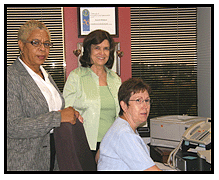 Dr. Patricia Worthington, Director, and administrative staff Susan Whitmore (seated) and Marge Lentzen
were recently recognized by Mr. Glenn Podonsky, DOE's Chief Health, Safety, and Security Officer, at an
all-hands meeting for their many years of service to the United States Federal Government. Their
experience totals 110 years and has included service to DOE, Air Force Civil Service, NRC, and NIH.
Their guidance to the staff of HS-10, as well as their support of other HSS and DOE program offices
is highly respected and appreciated. Please congratulate them when you see them and ask them for
the secrets of their successful careers!
Dr. Patricia Worthington, Director, and administrative staff Susan Whitmore (seated) and Marge Lentzen
were recently recognized by Mr. Glenn Podonsky, DOE's Chief Health, Safety, and Security Officer, at an
all-hands meeting for their many years of service to the United States Federal Government. Their
experience totals 110 years and has included service to DOE, Air Force Civil Service, NRC, and NIH.
Their guidance to the staff of HS-10, as well as their support of other HSS and DOE program offices
is highly respected and appreciated. Please congratulate them when you see them and ask them for
the secrets of their successful careers!
The Art of Medicine
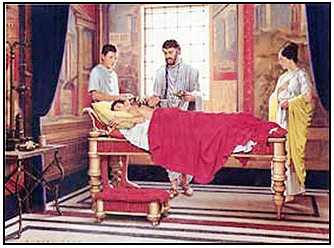 Greek physician Galen uses heated cups to draw blood to the surface as a preparation for blood-letting,
which he advocated for many ills. This painting by Robert Thom is one of his45 historical paintings given
by Pfizer, Inc, to the University of Michigan which has made them available to the public.
Greek physician Galen uses heated cups to draw blood to the surface as a preparation for blood-letting,
which he advocated for many ills. This painting by Robert Thom is one of his45 historical paintings given
by Pfizer, Inc, to the University of Michigan which has made them available to the public.
For more information, please visit the University of Michigan's on-line News Service
at: http://www.ur.umich.edu.
Dr. Patricia Worthington
Director, Office of Health and Safety
U.S. Department of Energy
1000 Independence Ave., SW
Washington, DC 20585-1290
E-mail: pat.worthington@hq.doe.gov
|
Dr. Michael Ardaiz
CMO, Office of Health and Safety
U.S. Department of Energy
1000 Independence Ave., SW
Washington, DC 20585-1290
E-mail: michael.ardaiz@hq.doe.gov
|
This newsletter can be found on the HS webpage:
http://www.hss.energy.gov/HealthSafety/
You may also provide feedback through links on the Newsletter website.
|
|
|

